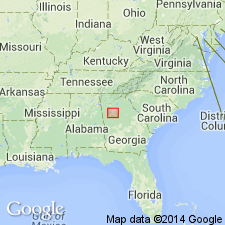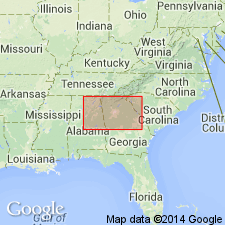
- Usage in publication:
-
- Hannah Member*
- Modifications:
-
- Named
- Dominant lithology:
-
- Quartzite
- Schist
- AAPG geologic province:
-
- Piedmont-Blue Ridge province
Summary:
The Hannah Member of the Promised Land Formation, here named in the Newnan-Tucker synform near Atlanta, GA, is a thin unit of quartzite and schist at the top of the Promised Land. Fresh outcrops are white. Thickness is 3 m. Age is Late Proterozoic and (or) early Paleozoic.
Source: GNU records (USGS DDS-6; Reston GNULEX).

- Usage in publication:
-
- Hannah Member†
- Modifications:
-
- Abandoned
- AAPG geologic province:
-
- Piedmont-Blue Ridge province
Summary:
The Hannah Member of the Promised Land Formation is here abandoned because rocks described as the member are now known to be mylonite schist along the Promised Land thrust fault at the base of the Promised Land thrust sheet.
Source: GNU records (USGS DDS-6; Reston GNULEX).
For more information, please contact Nancy Stamm, Geologic Names Committee Secretary.
Asterisk (*) indicates published by U.S. Geological Survey authors.
"No current usage" (†) implies that a name has been abandoned or has fallen into disuse. Former usage and, if known, replacement name given in parentheses ( ).
Slash (/) indicates name conflicts with nomenclatural guidelines (CSN, 1933; ACSN, 1961, 1970; NACSN, 1983, 2005, 2021). May be explained within brackets ([ ]).

